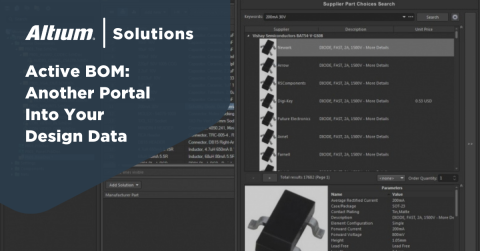Costed BOM: Expedite Cost Savings with Continually Updated BOM Pricing
Knowing your market and providing supply for your customers is an art. Purveyors of commodities have long been negotiating with their clients to plan supply chain needs. Stock becomes more desirable as supplies diminish, especially if demand grows and the need is great. If need and demand remain robust, pricing holds and suppliers make money while offering fair deals to their customers.
Electronic component vendors carefully plan their offerings for any given year. They rely on customers’ forecasts to determine demand for the upcoming year. Knowing worldwide need drives supply and pricing. Those prices trickle into the databases and, in turn, are listed on Bills of Material for products. Companies use this knowledge to cost all the pieces they’ll need to make their product. Managing quantities gives purchasing departments leverage for negotiating best pricing of parts.
PCB software is evolving to include BOM pricing for parts as soon as they instantiate into the schematic. Designers provide a BOM to their Purchasing partners as soon as possible to help enterprise forecasting. Knowing your demands helps leverage negotiations with suppliers before costs float up and bust your budget. Having BOM pricing early in the design cycle benefits your enterprise by purchasing parts before your competitors drive demand up, resulting in savings for your corporation.
Select Vendors Able to Supply Needed Quantities
When selecting parts for your circuit designs, it is good to know which vendors are on your enterprise approved vendor list. This means, among other things, that your purchasing and supply chain departments have evaluated and determined the best vendors for sourcing.
A big part of working with vendors is their ability to supply the part you need at a competitive price. One of the ways they do this is by working with their customers to determine product needs over the next few years. By meeting with customers and sharing product roadmaps, part vendors can manage their offerings competitively.
Use your roadmap to drive demand
Knowing vendor roadmaps allows part inclusion on the BOM for use over the life cycle of your design. Providing a costed BOM at schematic capture enables your purchasing department to negotiate competitive BOM pricing early for your enterprise.
Having the Bill of Material also allows your purchasing department to collect parts counts across all enterprise products. Having total count information allows your purchasing department to buy at quantity for price breaks, and allows your corporation to publish a forecast for each part used in the corporation’s product line.
Publish Forecast to Drive Demand for Parts
Vendors take forecasts from each of their customers to plan their offerings for the upcoming year. Everybody puts away some safety stock for unforeseen upticks in demand. It does happen in some years that forecasts have been low, and at the end of the year competitor companies, such as yours, will be scrambling for parts to keep their production lines going. It is good to have more orders for products, but if you run out of safety stock, demand will result in higher prices for raw materials and for parts.
With real-time BOM pricing active in your unified software, your company is able to see effects of supply and demand movement for specific parts. You will also be able to see the impact to your Bill of Materials, as the software updates all the time. In addition, if one vendor’s part is going up in price, ActiveBOM will give alternates in the tool, easy to access for consideration.
With information at your fingertips, without the need for additional collating, you are able to compare pricing and select the right part for both your design and for your corporation’s budget.
Manage the Sweet Spot for Pricing
In this way, you are able to find the sweet spot, not only for one part’s supply and demand adjustments but for choosing alternates should the price for one become too steep. With constantly updating availability and pricing of parts within ActiveBOM, adjustments to forecasts and quantity buys can be made often, refining the roadmap as your planning gets closer to production.
Consider the sweet spot of equilibrium when analyzing pricing life cycle
This is possible on demand because your unified environment within Altium Designer 18’s environment has the information at your fingertips throughout the life cycle of your products. There is no need to perform manual scrubs or prepare manually-generated spreadsheets for further manipulation and collating.
You have one location where the information is stored, and you can be confident it is always correct. If your designer goes in and makes small changes to the schematic, the change ripples through the documents and becomes available before there is a problem.
So get your enterprise on board for Altium Designer 18’s unified environment and use ActiveBOM to store electrical, mechanical, manufacturing, and BOM pricing in one place. You’ll be able to minimize the store of spreadsheets you manually keep and carve more time out of your day to support your production partners.
Using your unified printed circuit assembly software tools for schematic capture, PCB layout, and BOM management moves you into the sweet spot of parts pricing. If you’d like to find out more about using these tools, call an Altium expert to discuss.










